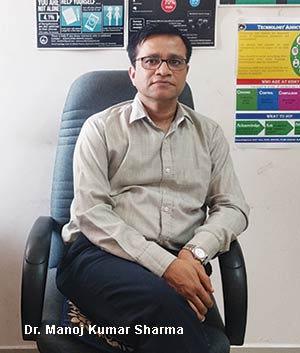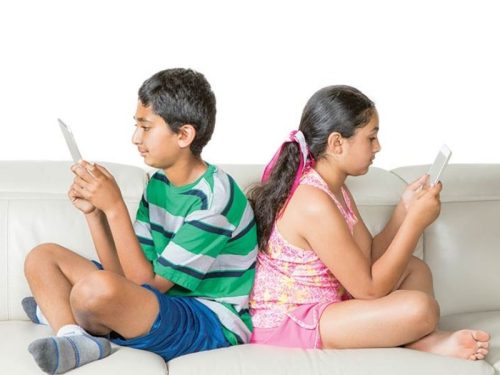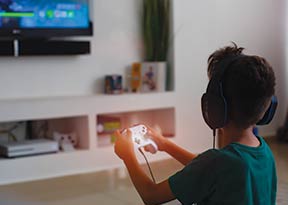Saving children from digital addiction
As digital devices — smart phones, computer tabs, laptops, gaming consoles, etc — become ubiquitous, children, especially adolescents, are increasingly becoming tech addicted with disastrous consequences. New research indicates that excessive on-screen time adversely impacts attention spans and creativity, limits social interaction and perhaps slows down the neural growth and development of children – Christobelle Joseph

Birmingham (UK)-based furniture manufacturing company Babeek has a new 21st century gizmo to offer to the ever-growing, high-potential parenting products industry. Launched in November, it’s a specially designed baby cot with — wait for it — an inbuilt iPad!
The designers, a young couple with a months-old infant daughter, say it’s ideal for stressed-out millennial parents as it emits ‘white noise’ — a special type of sound signal which suppresses distracting background sounds — to help infants sleep undisturbed. Customer response, however, has been underwhelming with numerous online consumers slamming the product for encouraging tech addiction from cradle stage.
 The child of the inventors of this £1,500 (Rs.135,250) crib isn’t a minority in the millennial generation that’s to-the-device-born; young, but certainly not the youngest to be raised on a diet of devices. According to Bangalore-based psycho-oncologist, Rhea Daruvala, who works with terminally-ill children, parents of infants as young as four months are using tech devices to distract their children.
The child of the inventors of this £1,500 (Rs.135,250) crib isn’t a minority in the millennial generation that’s to-the-device-born; young, but certainly not the youngest to be raised on a diet of devices. According to Bangalore-based psycho-oncologist, Rhea Daruvala, who works with terminally-ill children, parents of infants as young as four months are using tech devices to distract their children.
As digital devices — smart phones, computer tabs, laptops, gaming consoles, etc — become ubiquitous (according to a Unicef Child Online Protection in India Report 2016, 134 million children in India have access to mobile phones and the Internet), children, especially adolescents are increasingly becoming tech addicted with disastrous consequences. New research indicates that excessive on-screen time adversely impacts attention spans and creativity, limits social interaction and perhaps slows down the neural growth and development of children.
A recent study conducted by Dr. Manoj Kumar Sharma, professor of clinical psychology, SHUT (Service for the Healthy Use of Technology) clinic promoted by the prestigious National Institute for Mental Health and Neuro Sciences (NIMHANS), Bangalore, indicates that 73 percent of adolescents who use digital tech devices report dysfunction in one or more daily life activities. Adversely affected activities include sharply reduced interaction with friends (74 percent), academic performance (66 percent), sports (64 percent), engagement with relatives (61 percent) and social gatherings (55 percent).
 “Tech dependence within children and adolescents has reached alarming levels. I treat at least ten tech addiction cases every week. The teen years are the most productive age when children are expected to show academic and other achievements. But with adolescents becoming increasingly preoccupied with mobile phones, tabs and other devices, they are losing interest in academics and social activities. For teenage children with such behavioural changes and academic under-performance, parents often seek professional help but tech addiction of younger children is usually unchecked. Parents, teachers and schools need to collectively and urgently address this ballooning problem,” warns Sharma.
“Tech dependence within children and adolescents has reached alarming levels. I treat at least ten tech addiction cases every week. The teen years are the most productive age when children are expected to show academic and other achievements. But with adolescents becoming increasingly preoccupied with mobile phones, tabs and other devices, they are losing interest in academics and social activities. For teenage children with such behavioural changes and academic under-performance, parents often seek professional help but tech addiction of younger children is usually unchecked. Parents, teachers and schools need to collectively and urgently address this ballooning problem,” warns Sharma.
As awareness of the detrimental effects of excessive exposure to computers, smart phones, tablets, gaming consoles, etc is increasing, alarm bells are ringing within the parent-teachers community which is reluctantly beginning to debate on ways and means to combat this dangerous 21st century lifestyle disease. Anti-social behaviour in schools and the breakdown of family relationships have compelled parents, teachers and the intelligentsia to focus on the dangers of digital addiction.
Tech-drug addiction parallel
In a 2016 webinar, best-selling American author Brad Huddleston (Dark Side of Technology (2010), Digital Cocaine  (2015)) warned against the ‘digital high’ comparing it with cocaine addiction. “Brain scans — specifically-functional magnetic resonance imaging (MRI) scans — show that the brain of an individual engaged in digital activity reacts almost identically as to cocaine intake,” warns Huddleston.
(2015)) warned against the ‘digital high’ comparing it with cocaine addiction. “Brain scans — specifically-functional magnetic resonance imaging (MRI) scans — show that the brain of an individual engaged in digital activity reacts almost identically as to cocaine intake,” warns Huddleston.
The disturbing parallel between digital and drug addiction is reinforced by the withdrawal symptoms of digital addiction. Bangalore-based publisher and parent Dipika V. Maiya says the symptoms include, “withdrawal from fun/social activities, tantrums, eating disorders, excuses for inaction, short attention spans, and a lifeless, non-creative attitude.” Writer and parent Anupama G.S. adds “restlessness” and “impatience” to the list.
With family structures and dynamics changing rapidly, outdoor play spaces fast disappearing and households becoming focused on financial and personal goals, family and parent-child relationships are breaking down with a rising number of vulnerable children finding solace in digital gizmos and the Internet. According to a 2013 study conducted in Greece, there is a strong correlation between strict, unaffectionate parenting and heavy Internet use of children. “Good parenting which includes transference of warmth and affection, lowers the risk of Internet addiction whereas bad parenting — authoritarian and neglectful parenting styles — increases the probability of addiction,” says lead author Argyroula E. Kalaitzaki of the Technological Education Institute, Crete, which conducted the study.
 Undoubtedly, new 21st century digital technology devices and apps are posing unprecedented parenting challenges. Increasingly, millennial parents are experiencing the burden and stress of having to help their children navigate the multiplying dangers of the dark side of the digital world. “Most parents will benefit from professional counselling which will educate them about new ways to communicate with their children to win their trust and respect. I strongly advise schools to open up their counselling services to parents,” says Bangalore-based counselling psychologist Samiksha Jain.
Undoubtedly, new 21st century digital technology devices and apps are posing unprecedented parenting challenges. Increasingly, millennial parents are experiencing the burden and stress of having to help their children navigate the multiplying dangers of the dark side of the digital world. “Most parents will benefit from professional counselling which will educate them about new ways to communicate with their children to win their trust and respect. I strongly advise schools to open up their counselling services to parents,” says Bangalore-based counselling psychologist Samiksha Jain.
Nimhans’ Dr. Manoj Kumar Sharma (quoted earlier) also believes that parents need to be educated on how to wean children away from tech gadgets. “Imposing arbitrary bans limiting screen and gadgets usage time is not the solution. Whenever bans are imposed, they lead to increased usage. Instead, parents need to involve children in finding mutually acceptable solutions. For instance, we recommend that students take a break from headphones every 40 minutes. Moreover, gadget de-addiction rules have to be supplemented with generating awareness of healthy lifestyle alternatives. Teachers and parents should advocate the benefits of offline activities and pastimes such as outdoor sports and hobbies,” advises Sharma.
Indeed, counsellors and child psychologists are in agreement that the best way to reduce tech dependence is by way of cooperation rather than diktat. “Children need parental explanations about the causes and consequences of digital  dependence. This makes it easier for counsellors to subsequently advise parents and children,” says Suvish Samuel Sundaram, counselling psychologist at a well-known school.
dependence. This makes it easier for counsellors to subsequently advise parents and children,” says Suvish Samuel Sundaram, counselling psychologist at a well-known school.
In this connection, it’s pertinent to note that Brad Huddleston, author of Digital Cocaine and Dark Side of Technology (quoted earlier), cites “chaos in the home” as the prime reason for children’s tech dependence and/or addiction. He endorses the proposition that children seek solace in alternate digital universes when deprived of emotional security and affection at home. Huddleston recommends trashing the addictive device as the best option to deal with severe tech addiction cases — a solution which “child-fearing parents” aren’t willing to try. “There’s no pill we can give them that will allow children to use all this stuff and not harm their brains. Take it away,” he advises.
US-based Dr. Delaney Ruston, producer of the award-winning documentary film Screenagers (2016) which details parental confusion over children’s use of social media, video games, and internet addiction, believes communication is the key to helping children find a balance. Her website (https://www.screenagersmovie.com/) has started ‘Tech Talk Tuesdays’ to enable parents to initiate open conversations with their children. “It’s actually not too late… if you have teens and they have a device in their bedroom for example, to start a conversation and get it out of everyone’s bedroom. Conversation is good, but they will respect you when they see you do it too,” advises Ruston.
Unfortunately, the great majority of parents prefer not to confront their children in the hope problems will disappear if ignored. Psycho-oncologist, Rhea Daruvala, who works with terminally ill children, says it’s “unfortunate and sad” that parents are increasingly relying on tech devices to distract children suffering from illnesses and pain. “Children admitted into hospitals are given tech devices even though they can and must do therapeutic activities. These activities are easy, creative, and healing for both parent and child. But parents encourage use of tech devices instead because it’s the easier option. Establishing emotional connect with children is the better option therapeutically,” says Daruvala.
The consensus of advice is to not wait until there’s a full-blown crisis. Instead, parents need to communicate regularly, set and implement digital discipline and rules, and role model a tech-free lifestyle. “If parents and teachers make the effort to become role models, agents of change and provide secure home environments, encourage and negotiate flexible frameworks for tech usage and screen time, I am sure tech-dependence of children can be nipped  in the bud,” says Samiksha Jain.
in the bud,” says Samiksha Jain.
Huddleston’s research work indicates that healing in the most-affected parts of the brain follows within a few months of positive intervention by parents. But, parents have to take the initiative to wean children from tech devices and help them balance offline and online activities. Children don’t know any better. Parents have a duty to not indulgently rock the cradle of tech addiction.
Screen time: How much is too much?
A large number of children in urban India spend two-seven hours absorbed in interacting with digital devices daily. Against this, the American Academy of Paediatrics recommends a maximum of 1-2 hours of digital exposure per day including time spent on cell phones, computer tablets, gaming consoles, iPad, etc. Here are some digital screen time guidelines for children.
0-2 year-olds. The ideal is zero. In the crucial first two years of a child’s life, face-to-face human interaction and play with physical toys is important for stable cognitive, social and emotional development.
2-5 year-olds. An hour daily. Moreover, content should be carefully curated by parents.
6-18 year-olds. Two hours per day. This time limit is hard to enforce particularly for teenagers, with homework increasingly requiring computer usage. But the real danger is non-educational leisure screen time, so digital time spent on homework should be discounted.
10 signs that your child is becoming tech-addict
 She is preoccupied with gadgets even while not actively using them.
She is preoccupied with gadgets even while not actively using them.- Promises to use a gadget for half an hour but is unable or unwilling to leave the screen for hours. This signals loss of control.
- Losing interest in academic achievement
- Displays anger and irritation when a device is taken away
- Complains of dry eyes, pain in the neck, body fatigue, headaches
- Reduces outdoor activity, is constantly preoccupied with her cell phone, prefers gadgets to humans
- Accuses parents of mental/physical violence
- Indulges in binge watching of TV serials and/or videos
- Skips household chores/makes excuses to avoid responsibility
- Prefers to keep her mobile phone beside her at all times
















Add comment